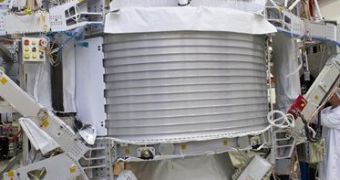The Alpha Magnetic Spectrometer (AMS) will leave the European Organization for Nuclear Research next Tuesday, heading for the Kennedy Space Center in Florida, the next step before getting to the International Space Station.
A press conference will be held at the Geneva International Airport at 9:00 CEST on 25 August, a day before the AMS' departure from Switzerland on board a US Air Force Galaxy transport aircraft, and journalists will have the opportunity to visit the AMS detector as well as the aircraft.
Robert Deillon, General Manager of Geneva International Airport said: “We are proud that this detector, which will play such an important role, will be flown from Geneva International Airport to the Kennedy Space Center in Florida.
The Alpha Magnetic Spectrometer's mission is to search for antimatter and dark matter in space, and, along with the Large Hadron Collider program, it should provide more information about the structure of the Universe.
In February it was tested for space travel at the European Space Research and Technology Center (ESTEC) in Noordwijk (Netherlands) and it returned to CERN for final modifications.
The main change was the replacement of the superconducting magnet with the permanent magnet from the AMS-01 prototype, that had already flown into space in 1998.
The reason for this is that the operational lifetime of the superconducting magnet would have been restricted to 3 years, because on board the ISS there is no way of refilling the magnet with liquid helium, that is necessary for maintaining the magnet’s superconductivity.
Now, the permanent magnet will keep the experiment operational for the entire lifetime of the space station.
Once the permanent magnet was installed, the AMS detector was tested with CERN particle beams, for validating and calibrating the new configuration.
After arriving in Florida, the AMS will undergo several tests and a few weeks later it will be moved to the space shuttle that will carry it to space for its last programmed flight, at the end of February 2011.
The AMS will measure cosmic rays in its search for antimatter and dark matter and all collected data will be transmitted to Houston (USA) and on to CERN’s Prévessin site, as well as to several regional physics analysis centers set up by the collaborating institutes.
Professor Sam Ting, Nobel laureate and spokesman for the experiment stated that “The entire AMS collaboration is delighted by this departure, because it marks a crucial milestone for the experiment.
“We are getting close to the space shuttle launch and the moment when our detector will finally be installed on board the ISS [and as] the detector’s construction phase is now finished, we are eager for the data collection phase to begin.”
Finally, the President of the Italian National Institute for Nuclear Physics, Roberto Petronzio, said that “The launch of AMS detector is very timely, [as] today we are well aware of our ignorance of Universe’s most abundant constituents and we still challenge the puzzle of matter-antimatter asymmetry.”

 14 DAY TRIAL //
14 DAY TRIAL //